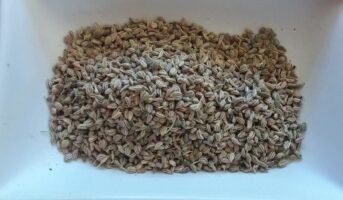The simplest plant to grow in a house garden is Cosmos bipinnatus. It may be cultivated by simply distributing the seeds and is renowned for its profusion of silky, daisy-like blossoms. Its vivid colour aids in luring birds, butterflies, and bees into the garden.
You can either plant Mexican aster in a container, in garden beds, or you can just use them as cut flowers.

Source: Pinterest
Cosmos bipinnatus: Facts
| Common Name | Cosmos, Mexican aster, cut-leaf cosmos |
| Family | Asteraceae |
| Type | Annual |
| Native | Mexico, Southern USA |
| Soil | Well-drained soil |
| Sun | Full exposure to sunlight |
| Bloom time | Summer through fall |
| Flower colour | Golden yellow, white, pink, magenta, orange, yellow and red |
Cosmos bipinnatus: Characteristics
Native to Mexico, Cosmos bipinnatus is frequently referred to simply as cosmos. It is a well-liked, low-maintenance, spectacular perennial that blooms late and grows to a height of 2 to 4 feet tall on upright stems covered in medium-green leaves that are deeply divided into threadlike segments. From early summer until frost, single, saucer-shaped, daisy-like flowers with red, pink, or white rays and yellow centres grow profusely. Plants may slow down significantly in the late summer in climates with hot, humid summers.
In many regions of the United States, plants have escaped gardens and naturalised, especially near roadsides, fields, and waste areas. On plants that range in height from dwarf to tall, cultivars have single, semi-double, or double flowers in a wider range of hues, including white and bicolour.
The plant has no known toxic effects, so you do not need to worry about keeping this plant around pets.
Cosmos bipinnatus: How to plant
- Choose from 20 different Cosmos plant kinds.
- A few weeks to four months before the final frost, sow cosmos seeds indoors.
- For best development, plant them in a spot with full light and well-drained soil.
- Take note that these plants can withstand both warm and dry conditions, and keep in mind that they self-seed.
Potting
Make sure the container has drainage holes on the bottom if you’re growing cosmos in pots. Cosmos cannot tolerate too moist, mucky soil. Per gallon of your container, aim to cultivate one cosmos plant. If you’re growing in pots, avoid enriching the soil because it encourages tall, lanky, and droopy plant growth. Tall varieties will also need to be staked in pots. Consider utilising a 12-inch-diameter, hefty container at a minimum.
Cosmos bipinnatus: How to take care
- Cosmos requires very little upkeep.
- In the event of an extended drought, water the plant.
- They can tolerate poor soil. Therefore, fertiliser is not necessary.
- Staking is necessary to prevent the tall plants from toppling over.
- Don’t forget to dispose of any dead or wilted flowers.
Light
For the best flowering, choose a place that receives direct sunshine. Despite having fewer blooms and being less vigorous when planted in shaded places, the cosmos will still flourish in partial shade. Similar to their natural home, the desert parts of Mexico and Central America, these plants will likewise flourish under the warmest temperatures with unbroken full sun.
Soil
While many flowering plants struggle in poor soil, soil cosmos plants thrive in neutral soil with a pH range of 6.0 to 8.0. They work best on soils with medium moisture and good drainage, although they can also function well in dry soils. Plants may grow too tall and topple over if they are planted in rich soil. By anchoring the plants or placing them adjacent to other plants that can sustain them, you can stop drooping.
Water
Unless there is a severe drought, you won’t need to water your cosmos plants once they are established. These are the final plants to need irrigation in areas with restricted water resources.
Temperature and Humidity
Cosmos prefer warm temperatures and can survive in any humidity level.
Fertiliser
Fertilising has a deleterious effect on the universe. Poor soil is no match for the cosmos. Strong plants with loads of foliage but few blossoms are frequently the results of using too much fertiliser. These plants don’t require fertiliser unless they appear to be having difficulties.

Source: Pinterest
Cosmos bipinnatus: Plant problems
Grey mould, powdery mildew, and stem canker are frequent problems. Aster Leafhoppers, Grey Looper Moths, and Aphids are a few examples of insects.
They might need to be staked because of their height. Defend against high winds. Plants with fewer flowers may be the result of over-watering or over-fertilising. Remove the spent blooms before the seed spreads to avoid self-seeding.
Cosmos bipinnatus: Uses
- Cosmos can be used as cut flowers as well as a backdrop or border annual. Cosmos plant has a pleasant aroma and attracts butterflies. The seeds are appealing to small finches. Cosmos can be used to attract beneficial insects such as lacewings, tachinid flies, hoverflies, and parasitic mini wasps, all of which prey on destructive insects.
- Cosmos has been used to treat jaundice, fever, and other conditions. There is little evidence that Cosmos has medicinal uses, though some claim it has antioxidant properties and can protect against oxidative DNA damage.
FAQs
What shades do cosmos blooms come in?
Cosmos bipinnatus has fused petals and comes in a variety of colours, including white, pale pink, and deep pink. Some have frilly centres as well.
Does Cosmos bipinnatus need sunlight to grow?
Yes. It will grow to about 80x40cm if you provide it with full sunlight and well-drained soil.
Housing News Desk is the news desk of leading online real estate portal, Housing.com. Housing News Desk focuses on a variety of topics such as real estate laws, taxes, current news, property trends, home loans, rentals, décor, green homes, home improvement, etc. The main objective of the news desk, is to cover the real estate sector from the perspective of providing information that is useful to the end-user.
Facebook: https://www.facebook.com/housing.com/
Twitter: https://twitter.com/Housing
Email: [email protected]











